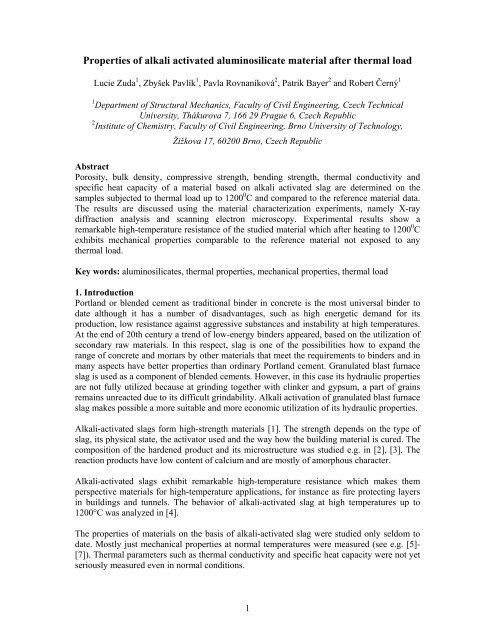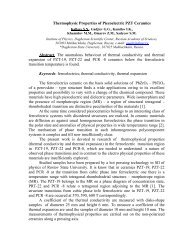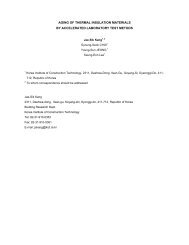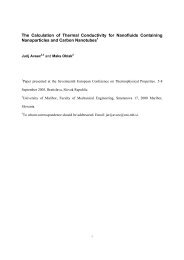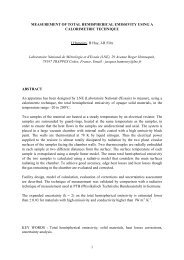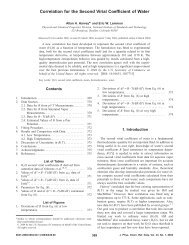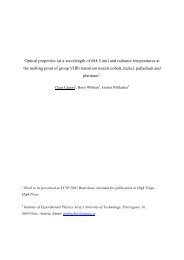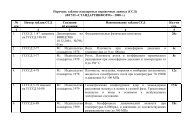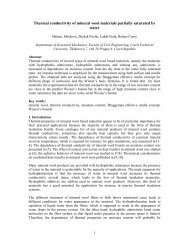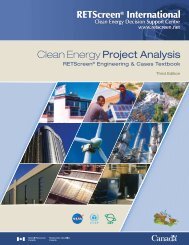Properties of alkali activated aluminosilicate ... - thermophysics.ru
Properties of alkali activated aluminosilicate ... - thermophysics.ru
Properties of alkali activated aluminosilicate ... - thermophysics.ru
Create successful ePaper yourself
Turn your PDF publications into a flip-book with our unique Google optimized e-Paper software.
<strong>Properties</strong> <strong>of</strong> <strong>alkali</strong> <strong>activated</strong> <strong>aluminosilicate</strong> material after thermal load<br />
Lucie Zuda 1 , Zbyšek Pavlík 1 , Pavla Rovnaníková 2 , Patrik Bayer 2 and Robert Černý 1<br />
1 Department <strong>of</strong> St<strong>ru</strong>ctural Mechanics, Faculty <strong>of</strong> Civil Engineering, Czech Technical<br />
University, Thákurova 7, 166 29 Prague 6, Czech Republic<br />
2 Institute <strong>of</strong> Chemistry, Faculty <strong>of</strong> Civil Engineering, Brno University <strong>of</strong> Technology,<br />
Žižkova 17, 60200 Brno, Czech Republic<br />
Abstract<br />
Porosity, bulk density, compressive strength, bending strength, thermal conductivity and<br />
specific heat capacity <strong>of</strong> a material based on <strong>alkali</strong> <strong>activated</strong> slag are determined on the<br />
samples subjected to thermal load up to 1200 0 C and compared to the reference material data.<br />
The results are discussed using the material characterization experiments, namely X-ray<br />
diffraction analysis and scanning electron microscopy. Experimental results show a<br />
remarkable high-temperature resistance <strong>of</strong> the studied material which after heating to 1200 0 C<br />
exhibits mechanical properties comparable to the reference material not exposed to any<br />
thermal load.<br />
Key words: <strong>aluminosilicate</strong>s, thermal properties, mechanical properties, thermal load<br />
1. Introduction<br />
Portland or blended cement as traditional binder in concrete is the most universal binder to<br />
date although it has a number <strong>of</strong> disadvantages, such as high energetic demand for its<br />
production, low resistance against aggressive substances and instability at high temperatures.<br />
At the end <strong>of</strong> 20th century a trend <strong>of</strong> low-energy binders appeared, based on the utilization <strong>of</strong><br />
secondary raw materials. In this respect, slag is one <strong>of</strong> the possibilities how to expand the<br />
range <strong>of</strong> concrete and mortars by other materials that meet the requirements to binders and in<br />
many aspects have better properties than ordinary Portland cement. Granulated blast furnace<br />
slag is used as a component <strong>of</strong> blended cements. However, in this case its hydraulic properties<br />
are not fully utilized because at grinding together with clinker and gypsum, a part <strong>of</strong> grains<br />
remains unreacted due to its difficult grindability. Alkali activation <strong>of</strong> granulated blast furnace<br />
slag makes possible a more suitable and more economic utilization <strong>of</strong> its hydraulic properties.<br />
Alkali-<strong>activated</strong> slags form high-strength materials [1]. The strength depends on the type <strong>of</strong><br />
slag, its physical state, the activator used and the way how the building material is cured. The<br />
composition <strong>of</strong> the hardened product and its microst<strong>ru</strong>cture was studied e.g. in [2], [3]. The<br />
reaction products have low content <strong>of</strong> calcium and are mostly <strong>of</strong> amorphous character.<br />
Alkali-<strong>activated</strong> slags exhibit remarkable high-temperature resistance which makes them<br />
perspective materials for high-temperature applications, for instance as fire protecting layers<br />
in buildings and tunnels. The behavior <strong>of</strong> <strong>alkali</strong>-<strong>activated</strong> slag at high temperatures up to<br />
1200°C was analyzed in [4].<br />
The properties <strong>of</strong> materials on the basis <strong>of</strong> <strong>alkali</strong>-<strong>activated</strong> slag were studied only seldom to<br />
date. Mostly just mechanical properties at normal temperatures were measured (see e.g. [5]-<br />
[7]). Thermal parameters such as thermal conductivity and specific heat capacity were not yet<br />
seriously measured even in normal conditions.<br />
1
The effect <strong>of</strong> high temperatures on mechanical properties <strong>of</strong> <strong>aluminosilicate</strong> materials was<br />
studied in [8] where the compressive strength <strong>of</strong> mortars on the basis <strong>of</strong> <strong>alkali</strong>-<strong>activated</strong> slag<br />
as function <strong>of</strong> heating up to 600 o C was measured. A similar effect on thermal properties was<br />
not yet studied at all. However, the information on the effect <strong>of</strong> high temperatures on the<br />
properties <strong>of</strong> <strong>aluminosilicate</strong> materials might be very useful in practical applications. The high<br />
temperature resistance <strong>of</strong> these materials could be so high that they possibly could survive the<br />
conditions <strong>of</strong> a fire. Then, their properties after thermal load would become a very important<br />
factor because they could be used even after high temperature exposure.<br />
In this paper, compressive and bending strength, thermal conductivity and specific heat<br />
capacity <strong>of</strong> an <strong>alkali</strong> <strong>activated</strong> <strong>aluminosilicate</strong> material are determined on the samples<br />
subjected to thermal load up to 1200 0 C and compared to the reference material data.<br />
2. Materials and samples<br />
Fine-ground slag <strong>of</strong> Czech origin (Kotouč Štramberk, Ltd.) was used for sample preparation.<br />
Its chemical composition is shown in Table 1, its granulometry in Table 2. As <strong>alkali</strong> activator,<br />
water glass solution was used. It was prepared using Portil-A dried sodium silicate preparative<br />
(Cognis Iberia, s.l. Spain). The sand aggregates were normalized according to EN 196-1 with<br />
the granulometry PG1, PG2, PG3. The composition <strong>of</strong> the mixture for sample preparation is<br />
presented in Table 3.<br />
Table 1 Chemical composition <strong>of</strong> applied slag<br />
SiO 2<br />
[%]<br />
Fe 2 O 3<br />
[%]<br />
Al 2 O 3<br />
[%]<br />
CaO<br />
[%]<br />
MgO<br />
[%]<br />
MnO<br />
[%]<br />
Cl-<br />
[%]<br />
Na 2 O<br />
[%]<br />
K 2 O<br />
[%]<br />
38.6 0.52 7.22 38.77 12.90 0.50 0.06 0.21 0.38 0.36<br />
Table 2 Slag granulometry<br />
0.045 mm<br />
[%]<br />
Sieve residue<br />
0.09 mm<br />
[%]<br />
Table 3 Composition <strong>of</strong> mixture for sample preparation<br />
Specific surface<br />
[cm 2 /g]<br />
12.4 1.9 3920<br />
Sand [g]<br />
Slag<br />
[g]<br />
Alkali-activation silicate<br />
admixture<br />
Water<br />
[ml]<br />
PG1 PG2 PG3<br />
[g]<br />
1350 1350 1350 450 90 190<br />
The technology <strong>of</strong> sample preparation was as follows. First, the silicate preparative was mixed<br />
with water. The solution was then mixed in the homogenized slag-sand mixture. The final<br />
mixture was put into 71x71x71 mm molds (for thermal parameters measurement) or<br />
40x40x160 mm molds (for mechanical parameters measurement) and vibrated. The specimens<br />
were demolded after 24 hours and then stored for further 27 days in water bath at laboratory<br />
temperature.<br />
SO 3<br />
[%]<br />
2
After the 28-days curing period, the specimens were dried at 110 0 C and after drying subjected<br />
to thermal load. Heating <strong>of</strong> the samples to the predetermined temperature was always done<br />
with the rate <strong>of</strong> 10 K/min, then the specimens remained at that temperature for the time period<br />
<strong>of</strong> two hours and finally they were slowly cooled. The chosen pre-heating temperatures were<br />
200 0 C, 400 0 C, 600 0 C, 800 0 C, 1000 0 C and 1200 0 C. Three specimens were investigated for<br />
each thermal state.<br />
3. Experimental methods<br />
First, the basic properties <strong>of</strong> the material were studied. The water vacuum saturation method<br />
and mercury porosimetry were used for the investigations.<br />
In the water vacuum saturation measurements, the bulk density and the open porosity were<br />
determined. Each sample was dried in a drier to remove majority <strong>of</strong> the physically bound<br />
water. After that the samples were placed into the desiccator with deaired water. During three<br />
hours air was evacuated with vacuum pump from the desiccator. The specimen was then kept<br />
under water not less than 24 hours.<br />
From the mass <strong>of</strong> the dry sample m d, the mass <strong>of</strong> water saturated sample m w , and the mass <strong>of</strong><br />
the immersed water saturated sample m a , the volume V <strong>of</strong> the sample was determined from<br />
the equation<br />
m w<br />
− m<br />
V =<br />
a<br />
ρl<br />
, (1)<br />
where ρ l is the density <strong>of</strong> water. The open porosity ψ 0 and the bulk density ρ were calculated<br />
according to the equations<br />
mw<br />
− md<br />
ψ<br />
0<br />
=<br />
Vρ<br />
m d<br />
l<br />
ρ =<br />
V . (3)<br />
(2)<br />
The mercury porosimetry measurements were performed using the porosimeter Micromeritics<br />
PORESIZER 9310 - maximum working pressure 200 MPa, pore distribution in the range <strong>of</strong><br />
300 µm to 0.006 µm. Both global characteristics <strong>of</strong> the porous space and the pore distribution<br />
curves were measured.<br />
The compressive strength and the bending strength were determined as the mechanical<br />
properties most characteristic for <strong>aluminosilicate</strong>s. The bending strength was measured by the<br />
standard three-point bending test using a 500 kN testing device. The compressive strength<br />
was determined by a compression test using the same device. It was done on the parts <strong>of</strong> the<br />
specimens broken at the bending test.<br />
The thermal conductivity and the specific heat capacity were the thermal properties<br />
determined for the studied material. The thermal conductivity was measured in laboratory<br />
conditions using the commercial device ISOMET 2104 (Applied Precision, Ltd.). ISOMET<br />
2104 is equipped with various types <strong>of</strong> optional probes, needle probes are for porous, fibrous<br />
or s<strong>of</strong>t materials, and surface probes are suitable for hard materials. The measurement is based<br />
3
on the analysis <strong>of</strong> the temperature response <strong>of</strong> the analyzed material to heat flow impulses.<br />
The heat flow is induced by electrical heating using a resistor heater having a direct thermal<br />
contact with the surface <strong>of</strong> the sample. The measurements were done in dependence on<br />
moisture content.<br />
The specific heat capacity <strong>of</strong> dry materials was determined by the mixing calorimeter method<br />
in a water calorimeter. Calibration <strong>of</strong> the water calorimeter (tight Dewar flask) was done by<br />
warm water <strong>of</strong> similar heat capacity as was that <strong>of</strong> the sample. To determine the specific heat<br />
capacity <strong>of</strong> wet materials we used the mixing <strong>ru</strong>le. The content <strong>of</strong> moisture in porous material<br />
does not significantly change its volume. So, we can write for the volumetric specific heat<br />
capacity ρ wet c wet [Jm -3 K -1 ]<br />
ρ wet c wet = ρ dry c dry + ρ w c w w (4)<br />
ρ wet = ρ dry + ρ w w, (5)<br />
where ρ wet is the bulk density <strong>of</strong> the wet material, ρ dry the bulk density <strong>of</strong> the dry material, ρ w<br />
the density <strong>of</strong> water [kgm -3 ], w the moisture content by volume [m 3 m -3 ], c wet, c dry and c w the<br />
specific heat capacities <strong>of</strong> the wet material, the dry material and water, respectively, [Jkg -1 K -<br />
1 ].<br />
4. Experimental results and discussion<br />
Table 4 shows the basic characteristics <strong>of</strong> the studied <strong>aluminosilicate</strong> material determined by<br />
water vacuum saturation method after thermal load. The porosity began to increase<br />
significantly after heating to 600 0 C, achieved its maximum at 800 0 C, and at 1000 0 C and<br />
1200 0 C it was not changed significantly.<br />
Table 4 Basic properties <strong>of</strong> the studied material measured by water vacuum saturation method<br />
in dependence on thermal load<br />
Thermal load<br />
[ 0 C]<br />
Porosity<br />
[m 3 /m 3 ]<br />
Bulk density<br />
[kg/m 3 ]<br />
25 0.18 2170<br />
200 0.22 2100<br />
400 0.17 2170<br />
600 0.22 2070<br />
800 0.24 2030<br />
1000 0.24 2050<br />
1200 0.23 2050<br />
The values <strong>of</strong> porosity determined by mercury porosimetry shown in Table 5 were<br />
systematically lower than those determined by water vacuum saturation method. This is an<br />
expected result in general because the dimensions <strong>of</strong> the samples are significantly lower for<br />
mercury porosimetry so that big pores and cracks may not be included in the resulting<br />
porosity value. However, the basic trend concerning the increase <strong>of</strong> porosity with temperature<br />
was confirmed and the values <strong>of</strong> porosity determined by both methods were closer each other<br />
with the increase <strong>of</strong> temperature. The most dramatic increase in porosity was for mercury<br />
porosimetric measurements observed again at 600 0 C. The values <strong>of</strong> porosity at 1200 0 C were<br />
for water vacuum saturation method and mercury porosimetry the same. This indicates a<br />
4
significant change <strong>of</strong> st<strong>ru</strong>cture and disappearance <strong>of</strong> major cracks not detectable by mercury<br />
porosimetry.<br />
Table 5 Basic properties <strong>of</strong> the studied material measured by mercury porosimetry in<br />
dependence on thermal load<br />
Thermal load<br />
[ 0 C]<br />
Total<br />
int<strong>ru</strong>sion<br />
volume<br />
[cm 3 /g]<br />
Total pore<br />
area<br />
[m 2 /g]<br />
Median pore<br />
diameter<br />
[µm]<br />
Bulk density<br />
[kg/m 3 ]<br />
Porosity<br />
[m 3 /m 3 ]<br />
25 0.053 1.53 5.09 2170 0.12<br />
200 0.061 3.02 4.97 2130 0.13<br />
600 0.096 7.92 5.53 2040 0.20<br />
1200 0.113 2.01 32.6 2050 0.23<br />
Fig. 1 presenting the pore distribution shows that while for lower temperatures the main peak<br />
was at about 3µm, after heating to 1200 0 C it was shifted to about 30µm where it already<br />
appeared in a less notable form after heating to 600 0 C. This indicates again a remarkable<br />
change in the st<strong>ru</strong>cture <strong>of</strong> the material after heating.<br />
0,0600<br />
Incremental pore volume [cm 3 /g]<br />
0,0500<br />
0,0400<br />
0,0300<br />
0,0200<br />
0,0100<br />
20 C<br />
200 C<br />
600 C<br />
1200 C<br />
0,0000<br />
1000,0000<br />
100,0000<br />
10,0000<br />
1,0000<br />
0,1000<br />
0,0100<br />
0,0010<br />
Pore diameter [µm]<br />
Fig. 1 Pore distribution curves <strong>of</strong> the studied material in dependence on thermal load<br />
Table 6 Mechanical properties <strong>of</strong> the studied material in dependence on thermal load<br />
Thermal load [ 0 C] Bending strength<br />
[MPa]<br />
Compressive strength<br />
[MPa]<br />
25 4.4 55.8<br />
200 4.4 44.6<br />
400 3.8 45.6<br />
600 2.6 31.4<br />
800 1.7 9.9<br />
1000 2.2 14.8<br />
1200 3.6 48.7<br />
5
Table 6 shows that the dependence <strong>of</strong> mechanical properties on heating temperature was not<br />
monotonic as it is usual for many other building materials. Both compressive strength and<br />
bending strength achieved their minimum values at 800 0 C where compressive strength was<br />
about 5 times and bending strength 2.5 times lower than for reference specimens, and then<br />
they began to increase. After heating to 1200 0 C, the compressive strength was only by about<br />
12% lower and the bending strength by 18% lower than those <strong>of</strong> reference specimens.<br />
Table 7 Thermal properties <strong>of</strong> dry material in dependence on thermal load<br />
Thermal load [ 0 C] Thermal conductivity<br />
[W/mK]<br />
Specific heat<br />
capacity [J/kgK]<br />
Thermal diffusivity<br />
[10 -6 m 2 /s]<br />
25 1.59 798 0.92<br />
200 1.60 781 0.99<br />
400 1.67 743 1.04<br />
600 1.09 754 0.70<br />
800 0.94 777 0.59<br />
1000 1.10 789 0.67<br />
1200 1.16 738 0.77<br />
The effect <strong>of</strong> heating temperature on thermal conductivity <strong>of</strong> the studied <strong>aluminosilicate</strong><br />
material in dry state is presented in Table 7. Similarly as with the porosity and the<br />
mechanical properties, the first remarkable change was observed for the heating to 600 0 C. The<br />
thermal conductivity decreased here by about 30% in comparison with the reference material<br />
and the decrease continued at 800 0 C where it achieved about 40%. For higher heating<br />
temperatures, the thermal conductivity was stabilized approximately on the values measured<br />
for 600 0 C heating.<br />
3,5<br />
3,0<br />
thermal conductivity [Wm -1 K -1 ]<br />
2,5<br />
2,0<br />
1,5<br />
1,0<br />
0,5<br />
200 C<br />
400 C<br />
600 C<br />
800 C<br />
1000 C<br />
1200 C<br />
25 C<br />
0,0<br />
0,00 0,02 0,04 0,06 0,08 0,10<br />
moisture content [kgkg -1 ]<br />
Fig. 2 Thermal conductivity <strong>of</strong> the studied material in dependence on moisture content and<br />
thermal load<br />
6
The heating temperature was also proved as an important factor for the shape <strong>of</strong> the thermal<br />
conductivity vs. moisture relation as it is evidenced in Fig. 2. The almost linear λ(T) function<br />
characteristic for the heating temperatures up to 400 0 C was suddenly changed into a convextype<br />
function for 600 0 C and then again into concave-type function for higher heating<br />
temperatures. Another interesting feature <strong>of</strong> the thermal conductivity measurements was that<br />
the maximum values achieved for highest moisture content were very similar for all heating<br />
temperatures taking into account the typical ±10% error range <strong>of</strong> the applied measuring<br />
method. These changes in the effect <strong>of</strong> water content on thermal conductivity indicate again<br />
significant st<strong>ru</strong>ctural changes in the material due to the high-temperature exposure.<br />
The changes in specific heat capacity <strong>of</strong> the dry <strong>aluminosilicate</strong> material due to heating in<br />
Table 7 were much less important than the changes in thermal conductivity. The typical<br />
differences were less than 5% which is on the edge <strong>of</strong> the error range <strong>of</strong> the measuring<br />
method. Therefore, we can conclude that the heating process did not lead to any detectable<br />
changes in specific heat capacity. The dependence <strong>of</strong> specific heat capacity on moisture<br />
content in Fig. 3 was also found to be quite regular, with no detectable differences between<br />
the cases corresponding to the particular heating temperatures.<br />
1,4<br />
specific heat capacity [10 3 Jkg -1 K -1 ]<br />
1,2<br />
1,0<br />
0,8<br />
0,6<br />
0,4<br />
0,2<br />
200 C<br />
400 C<br />
600 C<br />
800 C<br />
1000 C<br />
1200 C<br />
25 C<br />
0,0<br />
0,00 0,02 0,04 0,06 0,08 0,10<br />
moisture content [kgkg -1 ]<br />
Fig. 3 Specific heat capacity <strong>of</strong> the studied material in dependence on moisture content and<br />
thermal load<br />
The measurements <strong>of</strong> basic, mechanical and thermal parameters <strong>of</strong> the studied <strong>aluminosilicate</strong><br />
material in dependence on heating temperature revealed three important temperatures from<br />
the point <strong>of</strong> view <strong>of</strong> parameter changes. The first was 600 0 C when the first remarkable<br />
worsening <strong>of</strong> mechanical parameters appeared accompanied by increase in porosity and<br />
decrease in thermal conductivity. Here the changes in all studied properties corresponded well<br />
in a qualitative sense. The main reason for the worse mechanical properties <strong>of</strong> the material<br />
was probably the transition <strong>of</strong> SiO 2 in the aggregates from the β-form to the α-form which<br />
takes place at 573 0 C and is accompanied by volume changes. The damage <strong>of</strong> the interfacial<br />
7
zone is illustrated on the SEM image in Fig. 4. The X-ray diffraction analysis performed on<br />
the same material without aggregates for better identification <strong>of</strong> main features did not show<br />
any changes in the phase composition in the temperature range up to 600 0 C as it is<br />
documented in Fig. 5. The relatively high X-ray-amorphous background can be attributed to<br />
the CSH gels, i.e. to the main reaction product which maybe surprisingly was not yet<br />
decomposed at 600 0 C. The highest peaks on Fig. 5 corresponds to the mineral akermanite,<br />
Ca 2 MgSi 2 O 7 .<br />
Fig. 4 SEM image <strong>of</strong> the aggregate-binder interface after heating to 600 0 C<br />
Fig. 5 X-ray diffraction analysis <strong>of</strong> the studied <strong>aluminosilicate</strong> material without aggregates<br />
pre-heated to 200 0 C, 400 0 C and 600 0 C<br />
8
The second important temperature from the point <strong>of</strong> view <strong>of</strong> the properties <strong>of</strong> the studied<br />
<strong>aluminosilicate</strong> material was 800 0 C where the minima <strong>of</strong> mechanical properties and thermal<br />
conductivity and the maximum <strong>of</strong> porosity were achieved. Here, the main factor was the CSH<br />
gels decomposition as it is shown in XRD results in Fig. 6 where the X-ray-amorphous<br />
background practically disappeared. It should be noted that the amount <strong>of</strong> akermanite in Fig. 6<br />
dramatically increased compared to the lower temperatures which probably indicated the<br />
beginning <strong>of</strong> its crystallization but it was not yet reflected in mechanical properties<br />
improvement.<br />
Fig. 6 X-ray diffraction analysis <strong>of</strong> the studied <strong>aluminosilicate</strong> material without aggregates<br />
pre-heated to 800 0 C<br />
Fig. 7 X-ray diffraction analysis <strong>of</strong> the studied <strong>aluminosilicate</strong> material without aggregates<br />
pre-heated to 1200 0 C<br />
The third significant temperature was 1200 0 C where the mechanical properties were<br />
remarkably improved but the porosity remained on its high value and the thermal conductivity<br />
9
on the correspondingly low value. The most probable reason for this behavior was the growth<br />
<strong>of</strong> akermanite crystals on the seeds formed at lower temperatures which was promoted by the<br />
high temperature environment. This statement is supported by XRD results in Fig. 7 where<br />
the amount <strong>of</strong> akermanite phase was remarkably increased. The transition <strong>of</strong> the binder phase<br />
was after heating to 1200 0 C apparently completed. As it is documented in the SEM image <strong>of</strong><br />
the binder-aggregate interface in Fig. 8, the cracks in the binder phase disappeared due to a<br />
sintering process and the contact between aggregates and the new binder phase was<br />
reestablished. Therefore, the improvement <strong>of</strong> mechanical properties was quite logical. The<br />
difference in porosity and thermal conductivity as compared to the reference material was due<br />
to the appearance <strong>of</strong> new binder phase on the basis <strong>of</strong> akermanite which had different<br />
properties than the original CSH st<strong>ru</strong>cture.<br />
Fig. 8 SEM image <strong>of</strong> the aggregate-binder interface after heating to 1200 0 C<br />
5. Conclusions<br />
The results <strong>of</strong> measurement <strong>of</strong> basic, mechanical and thermal parameters <strong>of</strong> the<br />
<strong>aluminosilicate</strong> material based on slag <strong>alkali</strong> <strong>activated</strong> by water glass after thermal load up to<br />
1200 0 C in this paper revealed good perspectives <strong>of</strong> the material in practical applications. The<br />
original CSH st<strong>ru</strong>cture <strong>of</strong> the binder was after high-temperature exposure found to be<br />
gradually replaced by a new st<strong>ru</strong>cture based on akermanite which after heating to 1200 0 C<br />
exhibited superior mechanical properties well comparable with the properties <strong>of</strong> the original<br />
material not subjected to any thermal load. In addition, the porosity <strong>of</strong> the material was after<br />
heating to 1200 0 C significantly increased. This makes very good prerequisites for using the<br />
material in such applications where traditional cement based materials fail, for instance as fire<br />
protection materials, or using it in the form <strong>of</strong> protective layers for the current reinforced<br />
concrete st<strong>ru</strong>ctures, for instance in tunnels. Taking into account that the material is partially<br />
based on waste materials, which serve as secondary raw materials for the forming <strong>of</strong> the<br />
binder system, it is possible to consider it as a low-energy material, so that it meets a trend<br />
common in recent production processes.<br />
10
Acknowledgements<br />
This research has been supported by Czech Science Foundation, under grant No.103/04/0139.<br />
References<br />
1. Collins, F.G, Sanjayan, J.G. Cement and Concrete Research 29: 455 (1999).<br />
2. Wang, D.S., Scrivener, K.L. Cement and Concrete Research 25: 561 (1995).<br />
3. Song, S., Jennings, H.M. Cement and Concrete Research 29: 159 (1999).<br />
4. Rovnaníková, P., Bayer, P. Proceedings <strong>of</strong> CONSTRUMAT (VUT Brno, Brno, 2001), pp.<br />
49-55.<br />
5. Byfors, K., Klingstedt, G., Lehtonen, V., Pyy, H., Romben, L. ACI SP Proceedings 114:<br />
1429 (1989).<br />
6. Robins, P.J., Austin, S.A., Issaad, A. Materials and St<strong>ru</strong>ctures 25: 598 (1992).<br />
7. Douglas, E., Bilodeau, A., Malhotra, V.M. ACI Materials Journal 89: 509 (1992).<br />
8. Shoaib, M.M., Ahmed, S.A., Balaha, M.M. Cement and Concrete Research 31: 1533<br />
(2001).<br />
11


